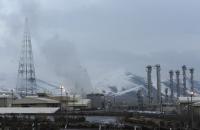-
N. Korea’s test of miniaturized warhead, submarine-launched ballistic missile, are game changers
North Korea has conducted its fifth nuclear test last night, marking the 68th anniversary of the nation’s founding. Military analysts say the test shows a worrisome improvement in North Korea’s nuclear capabilities: It was the most powerful nuclear test to date, with a 10-kiloton yield – slightly smaller than the yield of the bomb dropped on Hiroshima, estimated to have been between twelve and eighteen kilotons. The warhead tested in the explosion was miniaturized, indicating that North Korea now has the capability to mount a nuclear warhead on a missile. Last night’s test, together with North Korea’s proven progress in launching ballistic missile from submarines, mean that the country is getting closer to possessing a nuclear arsenal capable of hitting the United States.
-
-
Report: Hamas spends $100 million annually to build up its military infrastructure
Hamas spends an annual $100 million on its military infrastructure in order to prepare for its next war against Israel. Roughly $40 million is spent on employing around 1,500 diggers to build the Iran-backed terror organization’s network of tunnels. Despite the financial hardships experienced by Gaza residents, Hamas, which in 2014 had a budget of around $530 million, is intent on increasing its military spending. In addition to digging tunnels, it hopes to upgrade its capabilities, which were degraded during its war with Israel two years ago, and is seeking to develop more precise rockets that could evade Israel’s Iron Dome defensive shield.
-
-
Why ratifying the Chemical Weapons Convention is in Israel’s best interest
When the time came to commemorate the 100th anniversary of the first major use of chemical weapons, it seemed there was at last a real chance of ridding the world of all chemical weapons in the very near future. Almost all countries had already joined the Chemical Weapons Convention (CWC), which commits countries to the supervised destruction of all stockpiles of chemical weapons – with only two states as yet unwilling to sign: North Korea and Egypt. But there’s another exception: Israel, which has signed the convention but is refusing to ratify it. Chemical weapons have no place in a civilized society. They have little to no use as a tactical deterrent, and their effects are indiscriminate and appalling. We have a unique opportunity to rid the world of this scourge, and we’re so close to doing so. It’s high time Israel joined the rest of the world.
-
-
Syria chlorine attack claims: what this chemical is and how it became a weapon
New claims that the Syrian government has dropped barrel bombs full of chlorine on a suburb of Aleppo are the latest in a series of allegations of chemical weapon use. Although the Syrian government denies using chemical weapons, a recent UN-led enquiry found it had used chlorine on at least two occasions. The first gas attack using chlorine was launched on 22 April 1915 in the trenches on the Western front, near Ypres. Gas masks were developed to protect against chlorine attacks and other chemical warfare agents were developed. But chlorine remains the simplest chemical weapon and reappeared on the battlefield during the Iraq War and allegedly now in Syria. In the Second World War, both sides of the conflict knew that the other side had weaponized chlorine and refrained from using it. Today in Syria, it sadly appears this may not have been the case.
-
-
Rules governing targeted killing by U.S. drones need clarifying
Since the beginning of the conflicts in Iraq and Afghanistan, the United States has dramatically increased use of unmanned drones, developing technology to target and kill those identified as being terrorist leaders. Current U.S. policies on using drones for targeted killing are characterized by ambiguities in interpretations of international law and too many generalities, despite recent efforts by the Obama administration to clarify the policies, a new report finds.
-
-
Strengthening national security by improving intelligence software
An intelligence analyst hunting for answers in a sea of data faces steep challenges: She must choose the right search terms, identify useful results, and organize them in a way that reveals new connections. Making that process quicker and more intuitive could yield faster answers to key national security questions. Researchers are developing intelligence software that allows analysts to interact more closely with their data.
-
-
Tackling rumors during crises
The proliferation of rumors during a crisis can hinder efforts by emergency personnel trying to establish facts. That is why a doctoral student at BGU’s Department of Emergency Medicine has developed a methodology for tracking rumors and guidelines for how to control them.
-
-
Alabama public library threatens jail time for borrowers with overdue books
The Athens-Limestone Public Library in Athens, Alabama, has just about had enough with people who borrow books from the library and then take their time returning them. Accordingly, the library has warned people they could go to jail if they fail to return borrowed books on time.
-
-
White Nationalist groups growing much faster than ISIS on Twitter

The number of White Nationalists and self-identified Nazi sympathizers on Twiter had multiplied more than 600 percent in the last four years — outpacing ISIS in all social media aspects, from the number of follower counts to the number of daily tweets, a new study found. The study’s author notes that ISIS has gained a reputation for effectively using Twitter for propaganda and recruitment, but that White Nationalist groups have excelled even more in exploiting the medium. The report says that unlike the campaign Twitter has been conducting against ISIS, White Nationalists are continuing to use the service with “relative impunity.”
-
-
Iran received secret exemptions from complying with some facets of nuclear deal

The nuclear deal between the P5+1 powers and Iran – the official named is the Joint Comprehensive Plan of Action (JCPOA) — placed detailed limitations on facets of Iran’s nuclear program that needed to be met by Implementation Day, which took place on 16 January 2016. Most of the conditions were met by Iran, but some nuclear stocks and facilities were not in accordance with JCPOA limits on Implementation Day. In anticipation, the Joint Commission had earlier and secretly exempted them from the JCPOA limits. “Since the JCPOA is public, any rationale for keeping these exemptions secret appears unjustified,” say two experts. “Moreover, the Joint Commission’s secretive decision making process risks advantaging Iran by allowing it to try to systematically weaken the JCPOA. It appears to be succeeding in several key areas.”
-
-
A new generation of low-cost, networked, nuclear-radiation detectors
A DARPA program aimed at preventing attacks involving radiological “dirty bombs” and other nuclear threats has successfully developed and demonstrated a network of smartphone-sized mobile devices that can detect the tiniest traces of radioactive materials. Combined with larger detectors along major roadways, bridges, other fixed infrastructure, and in vehicles, the new networked devices promise significantly enhanced awareness of radiation sources and greater advance warning of possible threats.
-
-
The building evacuation needs of the mobility impaired
A fire alarm sounds. An announcement comes over the office public address system: “A fire has been reported in the building. This is not a drill. Please move to the nearest stairwell and exit the building.” As your colleagues leave their desks, you loosen the wheel locks on your wheelchair and wonder, “Will I be able to get out of the building?” This scenario is among the most common concerns reported in a new study detailing the challenges faced by people with mobility impairments during emergency evacuation from multistory buildings.
-
-
North Korea creates specials nuclear backpack units to infiltrate the South
North Korea has established a special infantry unit whose soldiers are being trained for a one-way mission: in the event of war with South Korea, they will infiltrate the South carrying nuclear devices in backpacks and detonate their weapons in the middle of population centers. North Korean military issued calls to the nation’s soldiers to become human “nuclear arsenals” in the event of war in the region. Military analysts said the units are, in effect, suicide squads, resembling the Japanese kamikaze pilots sent to attack Allied warships toward the end of the Second World War.
-
-
Libya’s remaining chemical weapons materials removed

The director-general of the Organization for the Prohibition of Chemical Weapons (OPCW), ambassador Ahmet Üzümcü, announced a milestone in the operation to verifiably eliminate Libya’s remaining chemical weapons stocks by confirming that the chemicals have been successfully removed from Libya on 27 August 2016.
-
-
Looking from space for nuclear detonations

Sandia has been in the business of nuclear detonation detection for more than fifty years, starting with the 1963 launch of the first of twelve U.S. Vela satellites to detect atmospheric nuclear testing and verify compliance with the Limited Test Ban Treaty of 1963 and subsequently the Threshold Test Ban Treaty of 1974. That marked the start of the U.S. Nuclear Detonation Detection System that supports treaty monitoring. The Global Burst Detection (GBD) system launched 5 February from Cape Canaveral aboard the 70th Global Positioning System (GPS) satellite. The GBD looks for nuclear detonations around the world, offering real-time information about potential activity to U.S. policymakers. The launch was the 12th and final of the Block IIF (GPSIIF) series of GPS satellites in medium Earth orbit.
-
More headlines
The long view
Why Was Pacific Northwest Home to So Many Serial Killers?
Ted Bundy, Gary Ridgway, George Russell, Israel Keyes, and Robert Lee Yates were serial killers who grew up in the Pacific Northwest in the shadow of smelters which spewed plumes of lead, arsenic, and cadmium into the air. As a young man, Charles Manson spent ten years at a nearby prison, where lead has seeped into the soil. The idea of a correlation between early exposure to lead and higher crime rates is not new. Fraser doesn’t explicitly support the lead-crime hypothesis, but in a nimble, haunting narrative, she argues that the connections between an unfettered pollution and violent crime warrant scrutiny.
Bookshelf: Smartphones Shape War in Hyperconnected World
The smartphone is helping to shape the conduct and representation of contemporary war. A new book argues that as an operative device, the smartphone is now “being used as a central weapon of war.”
